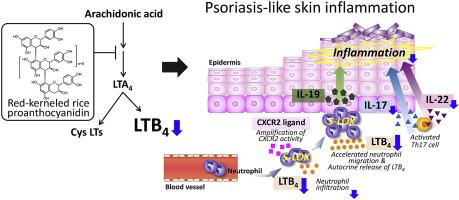当前位置:
X-MOL 学术
›
Arch. Biochem. Biophys.
›
论文详情
Our official English website, www.x-mol.net, welcomes your
feedback! (Note: you will need to create a separate account there.)
Red-kerneled rice proanthocyanidin inhibits arachidonate 5-lipoxygenase and decreases psoriasis-like skin inflammation.
Archives of Biochemistry and Biophysics ( IF 3.8 ) Pub Date : 2020-02-27 , DOI: 10.1016/j.abb.2020.108307 Keisuke Toda 1 , Izumi Tsukayama 1 , Yuki Nagasaki 1 , Yuka Konoike 2 , Asako Tamenobu 1 , Natsuki Ganeko 1 , Hideyuki Ito 1 , Yuki Kawakami 1 , Yoshitaka Takahashi 1 , Yoshimi Miki 3 , Kei Yamamoto 4 , Makoto Murakami 3 , Toshiko Suzuki-Yamamoto 1
Archives of Biochemistry and Biophysics ( IF 3.8 ) Pub Date : 2020-02-27 , DOI: 10.1016/j.abb.2020.108307 Keisuke Toda 1 , Izumi Tsukayama 1 , Yuki Nagasaki 1 , Yuka Konoike 2 , Asako Tamenobu 1 , Natsuki Ganeko 1 , Hideyuki Ito 1 , Yuki Kawakami 1 , Yoshitaka Takahashi 1 , Yoshimi Miki 3 , Kei Yamamoto 4 , Makoto Murakami 3 , Toshiko Suzuki-Yamamoto 1
Affiliation

|
5-lipoxygenase is a key enzyme in the synthesis of leukotrienes from arachidonic acid. The produced leukotrienes are involved in inflammatory diseases including psoriasis, asthma, and atherosclerosis. A suitable 5-lipoxygenase inhibitor might be useful for preventing and improving the symptoms of leukotriene-related inflammatory diseases. Here, we investigate the mechanism underlying the anti-inflammatory effect of a proanthocyanidin found in red-kerneled rice. Red-kerneled rice proanthocyanidin exhibited potent mixed noncompetitive inhibition of 5-lipoxygenase, with an IC50 of 7.0 μM. This compound decreased leukotriene B4 production in rat basophilic leukemia-2H3 cells. In imiquimod-induced psoriasis-like mouse skin, topical application of the proanthocyanidin suppressed hyperplasia, decreased inflammatory cell infiltration, and down-regulated expression of the psoriasis-associated genes Il17a, Il22, S100a9, and Krt1. Lipid metabolome analysis by electrospray ionization mass spectrometry showed that red-kerneled rice proanthocyanidin treatment of psoriasis-like mouse skin dose-dependently decreased the production of leukotriene B4 but no other arachidonate metabolites. Red-kerneled rice proanthocyanidin inhibits 5-lipoxygenase, resulting in a decrease in leukotriene B4 production and psoriasis-like mouse skin inflammation. These results suggest that this proanthocyanidin may be therapeutically effective for treating leukotriene-related diseases.
中文翻译:

红核米原花青素抑制花生四烯酸5-脂氧合酶并减少牛皮癣样皮肤炎症。
5-脂氧合酶是从花生四烯酸合成白三烯的关键酶。产生的白三烯与炎性疾病有关,包括牛皮癣,哮喘和动脉粥样硬化。合适的5-脂氧合酶抑制剂可用于预防和改善白三烯相关的炎性疾病的症状。在这里,我们调查了红花米中原花青素的抗炎作用的潜在机制。红核米原花青素显示出对5-脂氧合酶的有效混合非竞争性抑制,IC50为7.0μM。该化合物减少了大鼠嗜碱性白血病2H3细胞中白三烯B4的产生。在咪喹莫特诱导的牛皮癣样小鼠皮肤中,原花青素的局部应用可抑制增生,减少炎症细胞浸润,和银屑病相关基因Il17a,Il22,S100a9和Krt1的表达下调。电喷雾电离质谱法对脂质代谢组的分析表明,红核米原花青素治疗牛皮癣样小鼠皮肤的剂量依赖性地降低了白三烯B4的产生,但没有其他花生四烯酸盐代谢产物。红内核的大米原花青素抑制5-脂氧合酶,导致白三烯B4生成减少和牛皮癣样小鼠皮肤发炎。这些结果表明该原花青素对于治疗白三烯相关疾病可能是治疗有效的。电喷雾电离质谱法对脂质代谢组的分析表明,红核米原花青素治疗牛皮癣样小鼠皮肤的剂量依赖性地降低了白三烯B4的产生,但没有其他花生四烯酸盐代谢产物。红内核的大米原花青素抑制5-脂氧合酶,导致白三烯B4生成减少和牛皮癣样小鼠皮肤发炎。这些结果表明该原花青素对于治疗白三烯相关疾病可能是治疗有效的。电喷雾电离质谱法对脂质代谢组的分析表明,红核米原花青素治疗牛皮癣样小鼠皮肤的剂量依赖性地降低了白三烯B4的产生,但没有其他花生四烯酸盐代谢产物。红内核的大米原花青素抑制5-脂氧合酶,导致白三烯B4生成减少和牛皮癣样小鼠皮肤发炎。这些结果表明该原花青素对于治疗白三烯相关疾病可能是治疗有效的。
更新日期:2020-02-27
中文翻译:

红核米原花青素抑制花生四烯酸5-脂氧合酶并减少牛皮癣样皮肤炎症。
5-脂氧合酶是从花生四烯酸合成白三烯的关键酶。产生的白三烯与炎性疾病有关,包括牛皮癣,哮喘和动脉粥样硬化。合适的5-脂氧合酶抑制剂可用于预防和改善白三烯相关的炎性疾病的症状。在这里,我们调查了红花米中原花青素的抗炎作用的潜在机制。红核米原花青素显示出对5-脂氧合酶的有效混合非竞争性抑制,IC50为7.0μM。该化合物减少了大鼠嗜碱性白血病2H3细胞中白三烯B4的产生。在咪喹莫特诱导的牛皮癣样小鼠皮肤中,原花青素的局部应用可抑制增生,减少炎症细胞浸润,和银屑病相关基因Il17a,Il22,S100a9和Krt1的表达下调。电喷雾电离质谱法对脂质代谢组的分析表明,红核米原花青素治疗牛皮癣样小鼠皮肤的剂量依赖性地降低了白三烯B4的产生,但没有其他花生四烯酸盐代谢产物。红内核的大米原花青素抑制5-脂氧合酶,导致白三烯B4生成减少和牛皮癣样小鼠皮肤发炎。这些结果表明该原花青素对于治疗白三烯相关疾病可能是治疗有效的。电喷雾电离质谱法对脂质代谢组的分析表明,红核米原花青素治疗牛皮癣样小鼠皮肤的剂量依赖性地降低了白三烯B4的产生,但没有其他花生四烯酸盐代谢产物。红内核的大米原花青素抑制5-脂氧合酶,导致白三烯B4生成减少和牛皮癣样小鼠皮肤发炎。这些结果表明该原花青素对于治疗白三烯相关疾病可能是治疗有效的。电喷雾电离质谱法对脂质代谢组的分析表明,红核米原花青素治疗牛皮癣样小鼠皮肤的剂量依赖性地降低了白三烯B4的产生,但没有其他花生四烯酸盐代谢产物。红内核的大米原花青素抑制5-脂氧合酶,导致白三烯B4生成减少和牛皮癣样小鼠皮肤发炎。这些结果表明该原花青素对于治疗白三烯相关疾病可能是治疗有效的。











































 京公网安备 11010802027423号
京公网安备 11010802027423号